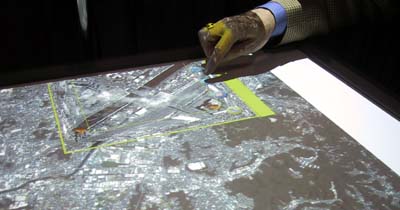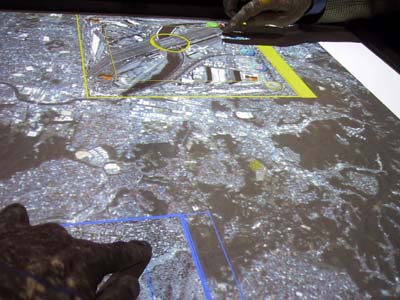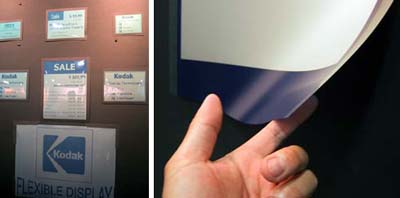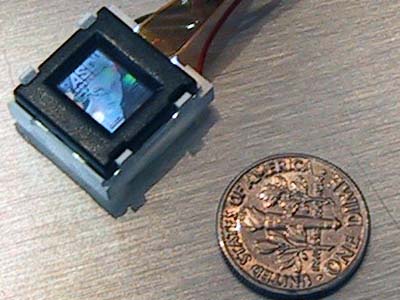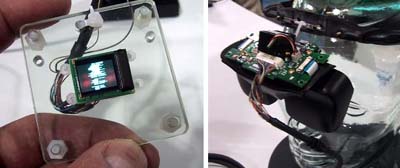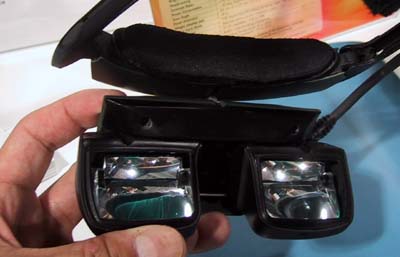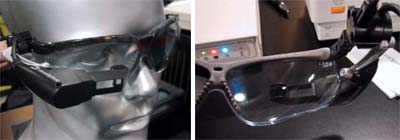
| TODAY |
| Lectures |
| Workshops |
| Gear & Gadgets |
| Destinations |
| Cruises |
| Airfare |
| Specials |
| Unaccompanied Minors |
| Carolyn's World |
| Contact Us |
| Destinations... |
||
Adam Bogue of Mitsubishi's Electric Research Lab (MERL) was demo-ing to us the DiamondTouch technology. The DiamondTouch technology allows multiple user to interact on the same display surface. In the photo above, Adam (in yellow) was using his finger to interact with the image displayed on the surface.
When I sat down, the sensor in my chair told the computer another user has joined the session and assigned me the color "blue". From that point on, we were able "collaborate" on the screen and the interactions were tracked individually. The military applications for this type of technology are obvious, but it also readily extends to more civilian uses like ordering food in a restaurant, drinks at a bar, and multi-player games. The DiamondTouch technology (in SDK form, about $10K) will be available to developers soon. BIG displays were everywhere at SID '05. Some displays were the normal LCDs, others were based on Organic Light Emitting Diodes (OLED) technology, but the most interesting displays to us were companies showing "flexible" technologies. We spent some time chatting with the Kodak folks about their flexible displays.
Flexible displays are still in their infancy (low res, monochrome). The obvious advantage over other display technology is "shape". Just imagine trying to "wrap" a display around a large round column. ... it would be pretty difficult using LCD or OLED... not so with flexible screens. However, flexible display also have many advantages that other technologies do not have... advantages like weight, low power consumption, and eventually low manufacturing cost. The display matrix material is essentially a layered sheet of thick plastic with a grid of material that responds to an applied charge to change it's optical characteristics. The Kodak folks were kind enough to let us flip it up to show just how thin and flexible the display material actually was. The material is manufactured in "rolls". The roll can be as long as 16" wide x 1000 feet long! That's a BIG display! At the other end of the display spectrum were the "micro-displays". Bryan Ma from Soloman Systech (makers of driver controllers) showed me one that was smaller a dime. We couldn't see what was on the display until we enlarged the photo we took!
What good are these micro-displays? Just ask a gamer! Bruce Westcoat at eMagin showed us some goggles with micro-displays, built-in head tracking, and a noise cancelling mic.
A pair of these can really get a gamer fully immersed in a RPG. A player will no longer have to use the mouse to look around in the game ... all they need to do is to just move their head in the direction and the scene will shift appropriately. We got a little dizzy from all the moving around, but maybe it was because of the weird 3D display monitor we were looking at just before we came to the eMagin booth :-) A local MA company, MicroOptical, also had some micro-display gear at the show. Their gear were more targeted at the "practical" markets (law enforcement, medical, military, etc...).
The main difference in MicroOptical's approach was they do not block out the surrounding field of view. We were able to quickly switch between looking at the information displayed in the monitor and our surroundings. The technology is ideal for information retrieval type applications. We did have some trouble balancing the glasses due to the uneven weight distribution, but the display was easy to read and we DID NOT get a headache.
|
Society for Information Display |
|
At RainyDayMagazine, we like to honor our geeky past every once in a while. We do that by attending the technical trade shows when they come to town. BioIT World was in town in mid May. We were there, but I just couldn't figure out how to make "high throughput microarray technology" entertaining so I passed on writing about it. This week, Boston is hosting SID'05... the Society for Information Display. Hmmm... big LCDs, 3D monitors, micro panels, immersive head gear... now that sounded more promising. We spent a few days speaking with the engineers and marketing folks on the floor. Some of the technologies were pretty interesting! We highlighted some of the ones that we thought were cool... at least to us :-)
|
||
